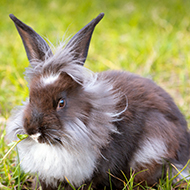Study reveals rabbit breeds most at risk of tear duct inflammation

Lionhead rabbits were among the groups found to be most likely to have dacryocystitis.
Lionheads, mini lops, lops and dwarf lops are among the rabbit breeds most at risk of developing dacryocystitis, an inflammatory condition of the tear ducts, a new study has found.
The findings, released by the Royal Veterinary College ahead of International Rabbit Day (24 September), could help researchers better understand how to prevent and manage the condition so that vets can advise owners accordingly.
Pet rabbits are predisposed to dacryocystitis because of the unique structure of their nasolacrimal ducts, which are narrow and prone to blockage. For this reason, the condition is associated with various other respiratory, dental, ocular and aural issues that can be uncomfortable and painful for the animal.
In the study, researchers analysed medical records from all rabbit cases evaluated at a single first opinion/referral UK exotics clinic between 2015 and 2018. The review included data from 821 rabbits documenting their most recent weight, sex, neuter status, breed and presence of lop ears.
They found that 6.7 per cent of the rabbits in their study had dacryocystitis and, of these, 45 per cent had dental disease and 38 per cent had respiratory disease. The team also identified concurrent ocular disorders in 23 per cent of the rabbits and aural disease in 13 per cent.
Furthermore, the study revealed that breed status and sex/neuter were the principal risk factors in developing dacryocystitis, with male neutered rabbits and lionheads, mini lops, lops and dwarf lops among the groups most likely to have the condition.
Interestingly, these breeds are frequently brachycephalic, indicating that further research is required to determine the association between sex, breed and condition, the RVC said. The researchers hope the findings will help veterinary professionals advise owners and lead to more studies into breed susceptibility.
Dr Joanna Hedley, a senior lecturer in exotic species and small mammal medicine and surgery at the Beaumont Sainsbury Animal Hospital, RVC, said: “This research has been crucial in helping us conclude that a breed predisposition for dacryocystitis may exist, particularly for the popular Lionhead and Dwarf Lop rabbits. We hope that these findings can now help us better understand how to prevent and manage this condition so that vets can advise owners accordingly.”
The study, Retrospective study identifying risk factors for dacryocystitis in pet rabbits, is published in Vet Record.



 The BSAVA has opened submissions for the BSAVA Clinical Research Abstracts 2026.
The BSAVA has opened submissions for the BSAVA Clinical Research Abstracts 2026.